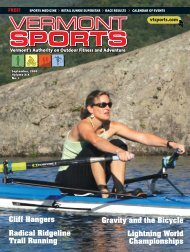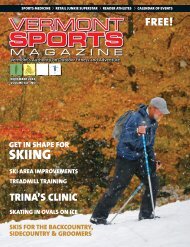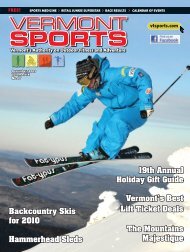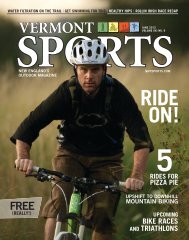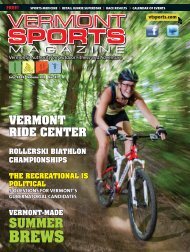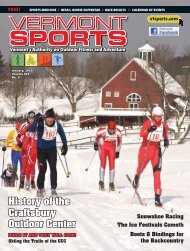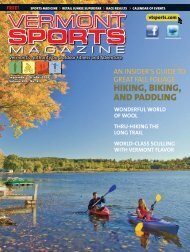Create successful ePaper yourself
Turn your PDF publications into a flip-book with our unique Google optimized e-Paper software.
Whether it’s the haunted past of<br />
<strong>Vermont</strong>’s Glastenbury Mountain,<br />
the challenging steeps of the Bristol<br />
Cliffs, or the mature hardwoods of<br />
the new Battell Wilderness Area,<br />
there is something undeniably<br />
special about backcountry skiing in <strong>Vermont</strong>’s federally<br />
designated wilderness areas. Not surprisingly, after<br />
countless days spent backcountry skiing through these<br />
areas over the years, we can still count the number<br />
of skiers we’ve come across on our own two hands.<br />
As populated as <strong>Vermont</strong> is, our most wild and scenic<br />
mountain lands remain relatively unexplored by skiers,<br />
and skiing through them in the wintertime is your ticket<br />
to Green Mountain solitude.<br />
Skiing and non-skiing <strong>Vermont</strong>ers have been hard<br />
at work since the early 1970s, protecting over 100,000<br />
acres of our Green Mountain National Forest—an area<br />
representing less than 2 percent of <strong>Vermont</strong>’s total land<br />
area—as designated wilderness. And the recent passage<br />
of the 2006 New England Wilderness Act created two<br />
valuable new wilderness areas in <strong>Vermont</strong>—Glastenbury<br />
Mountain and the Joseph Battell Wilderness Area—<br />
while expanding existing areas such as Breadloaf, Peru<br />
Peak, and Lye Brook Wilderness Areas. These areas are<br />
open to only the most traditional forms of wilderness<br />
travel and recreation—hiking, hunting, fi shing, camping,<br />
skiing, snowshoeing, birding, and nature study. They<br />
are protected from road building, logging, new mining<br />
claims, and motorized uses.<br />
Wilderness designation of this sort, as defi ned by the<br />
1964 Wilderness Act, is the highest level of protection<br />
that can be granted to federal land. Wilderness protects<br />
many of <strong>Vermont</strong>’s largest undeveloped and roadless<br />
landscapes, and adjacent areas of undeveloped private,<br />
state-owned, or National Forest land only add to the<br />
scale and remoteness of these areas by creating a buffer<br />
from nearby roads and settlements. Be it a morning ski<br />
tour or a multi-day ski camping adventure, <strong>Vermont</strong>’s<br />
wilderness areas offer no shortage of options for all levels<br />
of backcountry skiers. Here are a few of our favorite<br />
places to ski in <strong>Vermont</strong>’s wilderness.<br />
JOSEPH BATTELL WILDERNESS AREA<br />
Size: 12,333 acres<br />
Location: Goshen/Hancock/Rochester, VT<br />
Skiing highlights: Mature hardwoods: medium-angle<br />
touring<br />
One of <strong>Vermont</strong>’s newest wilderness areas, the over<br />
12,000-acre “Battell” was originally a gift to Middlebury<br />
College from late 1800s publisher and philanthropist<br />
Joseph Battell. Battell stood for the long-term protection<br />
of our forest lands and can also be credited for the<br />
creation of Camel’s Hump State Park. With fi ve peaks<br />
over 3,000 feet, the Battell is also home to some of the<br />
most mature stands of hardwood forest in <strong>Vermont</strong>. It<br />
also lays claim to one of the longest road-free stretches<br />
of the Long Trail.<br />
With Middlebury Gap and the Middlebury Snow<br />
Bowl at its north end, and Brandon Gap at its south end,<br />
access to the higher reaches of the Battell, via the Long<br />
Trail, is straightforward. However, actually skiing the<br />
Long Trail can be very challenging and should only be<br />
attempted if you have great confi dence in your skiing<br />
abilities. As an alternative, the Battell also protects<br />
the headwaters for the clear-running Bingo Brook, in<br />
Rochester, along which runs an unplowed class four road<br />
that provides good lower-elevation access to the forests<br />
and larger peaks in the northern portion of the Battell.<br />
As is the case with most of <strong>Vermont</strong>’s wilderness areas,<br />
there are no designated ski trails in the Battell, and the<br />
best skiing is found off-piste, if you’re willing to explore<br />
for it.<br />
BIG BRANCH WILDERNESS AREA<br />
Size: 6,767 acres<br />
Location: Danby/Mount Tabor, VT<br />
Skiing highlights: Steep, west-facing hardwoods; lowangle<br />
touring<br />
The Big Branch is a Green Mountain gem featuring<br />
a great mix of terrain that is dominated by a forest of<br />
maple, beech, and birch trees, and a healthy population<br />
of moose. Baker Peak, at nearly 3,000 feet, offers<br />
tremendous views of Dorset and Netop Mountains<br />
(other great ski objectives) across the upper Otter Creek<br />
Valley to the west, as well as views to the north and<br />
south along the Long Trail. With good snowpack, the<br />
steeper mountainsides to the west of the Long Trail,<br />
both to the north and south of Baker Peak, offer expert<br />
backcountry skiers with good noses for open lines some<br />
truly rewarding descents.<br />
Many cross-country skiers access the region by skiing<br />
northeast along the unplowed Brooklyn/Mount Tabor<br />
Road, and then south along the Long Trail into the higher<br />
reaches of the northern half of the Big Branch. This area<br />
is known for its gently sloping forests and beautiful offtrail<br />
ski touring. Just east of Baker Peak, Elbow Swamp<br />
is one of the largest higher-elevation swamp areas in the<br />
state, and offers a truly unique environment for winter<br />
exploring.<br />
Immediately south of the Big Branch is the equal-<br />
sized Peru Peak Wilderness Area, which, with its higher<br />
peaks (over 3,300 feet) and their moderately pitched,<br />
east-facing drainages, only adds to the great variety of<br />
ski terrain to be found in the Big Branch/Peru Peak area.<br />
Combined, these two areas make a great destination for<br />
multi-day ski-camping adventures, or extended, pointto-point<br />
day trips.<br />
Brian Mohr and his wife, Emily Johnson, contribute<br />
regularly to the outdoor media, co-own Ember Photography,<br />
and recently launched a new skiing website:<br />
www.AdventureSkier.com.<br />
February 2010 <strong>Vermont</strong> <strong>Sports</strong> 15



